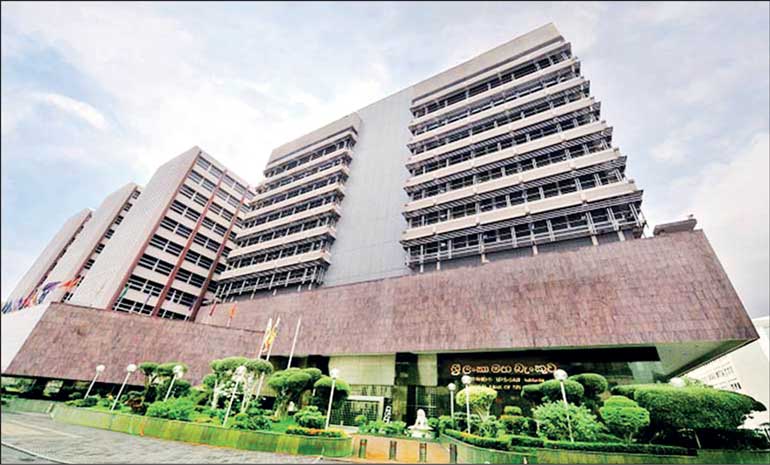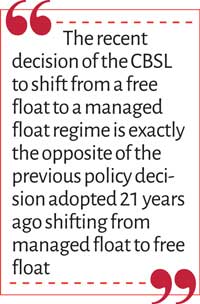Wednesday Dec 24, 2025
Wednesday Dec 24, 2025
Wednesday, 18 May 2022 00:30 - - {{hitsCtrl.values.hits}}

The Central Bank of Sri Lanka
In its latest attempt to prevent further depreciation of the rupee, the Central Bank of Sri Lanka (CBSL) has reintroduced managed exchange rate floating with effect from 13 May 2022, after a lapse of two decades.
decades.
Accordingly, the CBSL has begun to announce a middle rate for the US dollar/SL rupee exchange rate for interbank transactions along with permitted variation margins on a daily basis. The CBSL determines the middle rate based on the previous day’s weighted average spot exchange rate prevailed in the interbank market. Licensed banks have been requested to quote buying and selling rates for currencies within the specified margin for their transactions with the customers.
Instant rupee appreciation
The middle rate for 13 May started from Rs. 360.00 with a permitted variation of (plus or minus) Rs. 2.60. Following this guidance, the rupee appreciated by 3.3% to Rs. 365 per US dollar on 13 May from Rs. 377 on the previous day. The rupee appreciation occurred for the first time since the exchange rate was fixed late last year and since the free-floating of the currency in early March this year.
As envisaged by the CBSL, the managed float would strengthen the exchange rate and thereby ease the liquidity pressures in the domestic foreign exchange market. However, it is doubtful whether the CBSL would be able to sustain it for long due to the lack of foreign reserves to defend the rupee and emerging inflationary pressures.
What is managed floating?
Pure floating and fixed exchange rates, known as corner solutions, are the two extreme regimes of exchange rate management. Many countries, however, adopt an intermediate regime within the broad spectrum of corner solutions. Such intermediate regimes are characterised by significant foreign exchange market interventions by central banks and a certain degree of exchange rate flexibility.
A managed exchange rate float, also known as ‘dirty float’, is an intermediate regime in which the exchange rate is neither entirely fixed nor free floating. Instead, the value of the local currency is kept within a range against a foreign currency (or a basket of currencies) by central bank intervention.
Limits of managed floating
Although managed float would help to facilitate private sector activities by reducing foreign exchange market volatility, it might create harmful effects, particularly on the export sector, if the central bank attempts to keep the margins below market-clearing levels giving rise to an overvalued exchange rate.
Central banks can intervene in the foreign exchange market by buying or selling foreign currency to keep the exchange rate within the announced band. A key prerequisite for effectively managed floating in such a manner, therefore, is that the country’s central bank should have sufficient foreign reserves to pump dollars into the market when the domestic currency is depreciating beyond the specified margins.
keep the exchange rate within the announced band. A key prerequisite for effectively managed floating in such a manner, therefore, is that the country’s central bank should have sufficient foreign reserves to pump dollars into the market when the domestic currency is depreciating beyond the specified margins.
Managed float abandoned two decades ago
As a core component of the economic liberalisation policy package launched in November 1977, a managed float exchange rate system was adopted in Sri Lanka replacing the fixed exchange rate system that had been in operation until then. Accordingly, the CBSL announced buying and selling rates for the US dollar for its transactions with commercial banks, and the banks were required to quote buying and selling rates for currencies within the specified margin for their customers. The margin between the CBSL’s buying and selling rates was gradually raised over the years.
The CBSL abandoned the managed floating regime in January 2001, as it failed to tackle the severe balance of payments crisis and heavy drain of foreign reserves encountered in the latter part of 2000. Instead, the CBSL shifted to an independent floating regime which helped to lessen the foreign reserve outflows and reduce market expectations for greater rupee depreciation and thereby to stabilise the exchange rate.
The recent decision of the CBSL to shift from a free float to a managed float regime is exactly the opposite of the previous policy decision adopted twenty-one years ago shifting from managed float to free float.
Exchange rate under pressure
The exchange rate is currently under tremendous pressure due to the continuous deterioration of the balance of payments and the drain of foreign reserves. In the first quarter of this year, the trade deficit rose to $ 2,402 million from $ 2,059 million in the same period in 2021 due to an increase in imports. Workers’ remittances were down by 58% in the first quarter of this year. Tourist earnings too remained low.
The overall external deficit doubled in the first quarter of this year to $ 2,269 million from $ 1,101 in the corresponding period last year. This gap had to be filled either by depleting foreign reserves or foreign borrowings. As the country does not possess adequate reserves, resorting to foreign borrowings is the next option. The space available for foreign borrowings too is extremely limited due to the country’s debt default situation and the low global credit ratings.
The short supply of dollars resulting from the deteriorating balance of payments, as explained above, exerts constant pressure on the exchange rate compelling further depreciation of the rupee. Hence, it would be extremely difficult to reduce foreign exchange market volatility through the newly-introduced managed floating, as expected by the CBSL.
Exchange rate pass-through to inflation
The impact of changes in the exchange rate on domestic prices, which is known as the pass-through effect, is a key transmission shock in an open economy. It can be defined as the percentage change in prices in response to a 1% change in the exchange rate. Understanding the extent and duration of the exchange rate pass-through to import prices and to final consumer prices is critically important for prudent exchange rate management.
effect, is a key transmission shock in an open economy. It can be defined as the percentage change in prices in response to a 1% change in the exchange rate. Understanding the extent and duration of the exchange rate pass-through to import prices and to final consumer prices is critically important for prudent exchange rate management.
While depreciation of the local currency leads to an increase in import prices and domestic prices, the resulting inflation triggers pressure on the exchange rate calling for a further round of depreciation of the local currency. This goes on in the form of a vicious circle of exchange rate depreciation and inflation. Sri Lanka is already experiencing such a vicious circle recording a year-on-year rupee depreciation of 85% against the US dollar and a year-on-year inflation rate of 30% by now.
The cost-push inflation caused by exchange rate depreciation could be aggravated by wage increases.
Demand-pull inflation
On the demand side, the country is already experiencing inflationary pressures emanating from excessive money printing by the CBSL to finance the widening budget deficit. The Government is to raise the Treasury bill limit shortly from Rs. 3,000 billion to Rs. 4,000 billion to meet wage bills and other essential payments in the coming months. This will lead to further increases in Treasury bill yield rates which have already reached 25% per annum for all maturities.
As the market would be unable to absorb the entire Treasury bill issues at acceptable yield rates weekly, the CBSL will have to purchase the unsold stock resulting in continuous money printing and inflationary pressures.
All in all, inflation causes an appreciation of the real exchange rate calling for depreciation of the rupee to reduce imports and to maintain export comparativeness.
Rupee depreciation unstoppable
Given the severe balance of payments difficulties, foreign reserve depletion, and galloping inflation, the CBSL will find it extremely difficult to sustain the recently-announced exchange rate margins under the managed float for long and prevent further depreciation of the rupee.
As long as the official exchange rate band is kept below the market clearing level, black market foreign exchange transactions will continue to thrive despite CBSL’s stern warnings.
(The writer is Emeritus Professor of Economics at the Open University of Sri Lanka and a former Central Banker, reachable at [email protected].)